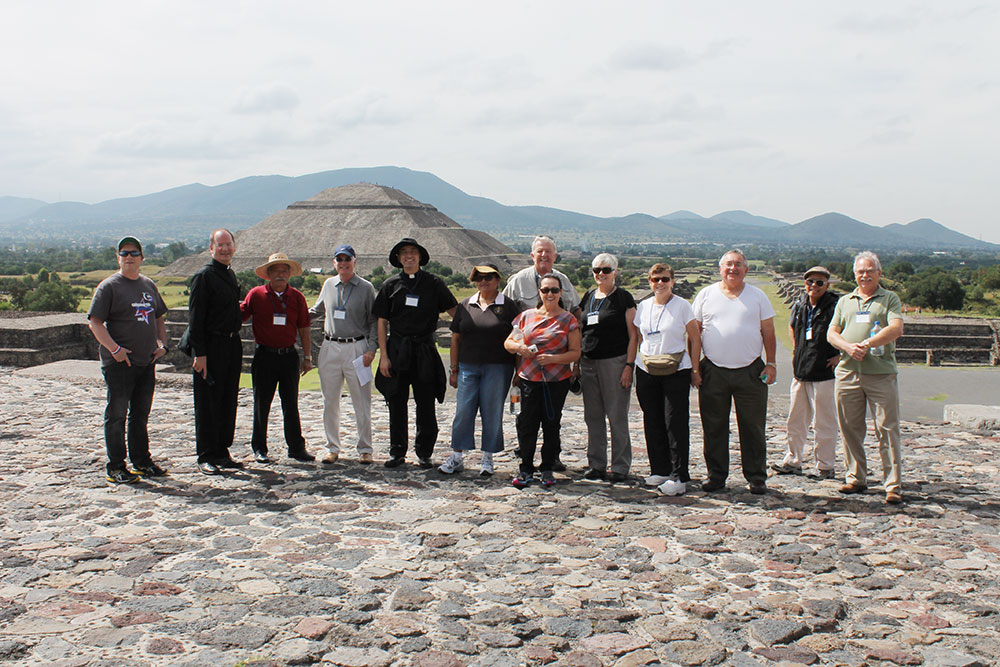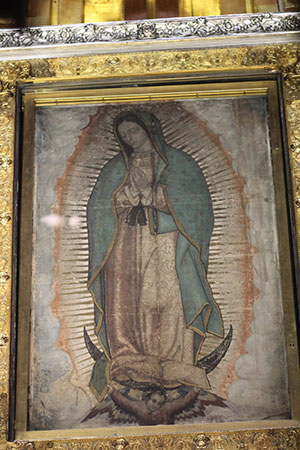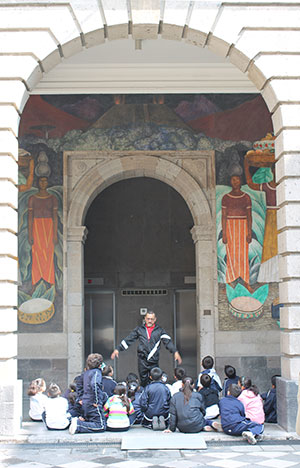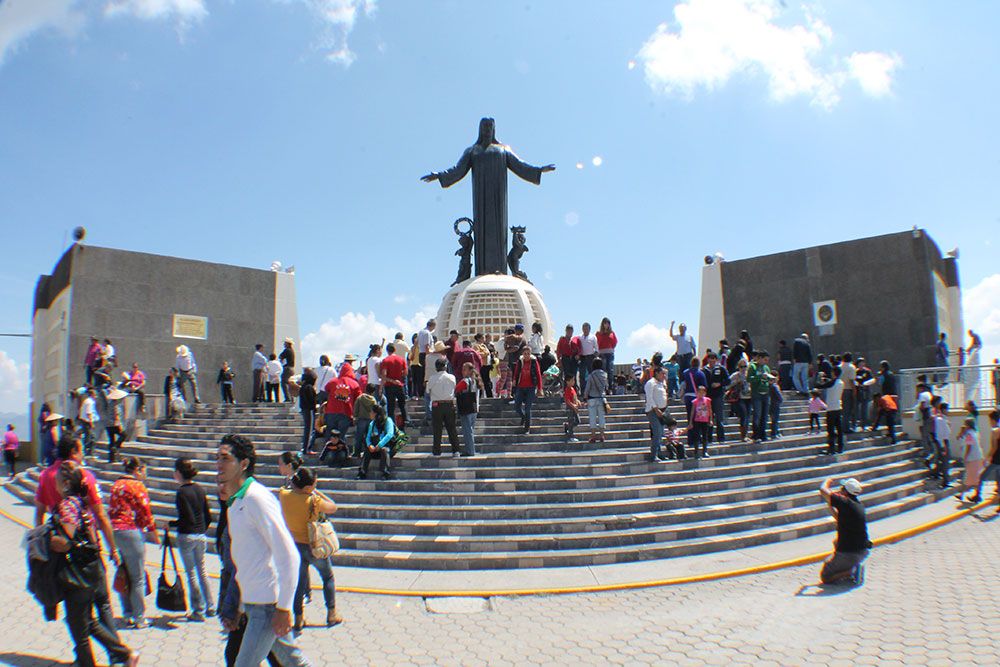
Maria Renteria wasn’t using her cane as she shuffled out of customs at Phoenix Sky Harbor International Airport. Her family was waiting for her, so she gave her cane to a friend so that they would come to believe as she believes.

“La Virgen me sanó,” she said as she walked, “The Virgin healed me.”
Renteria joined Auxiliary Bishop Eduardo A. Nevares and nearly 50 pilgrims on the Diocese of Phoenix Year of Faith pilgrimage to Mexico City and Guanajuato Oct. 7-14.
Pope Benedict XVI declared a Year of Faith, which concludes Nov. 24, to call Catholics to turn back to Jesus and enter into a deeper relationship with Him. The diocesan pilgrimage brought Catholics closer to Christ through His Mother and through a fuller appreciation of the origin of Christianity in the Western Hemisphere.
“She is the great intercessor. She has great compassion for each of us,” Bishop Nevares said in his Oct. 7 homily at the Shrine of San Hipólito. The pilgrims stopped at the Mexico City shrine before even stepping foot in the hotel. Oct. 7 is the Feast of Our Lady of the Rosary.
Before visiting the Basilica of St. Mary of Guadalupe, pilgrims climbed to the Pyramids of the Sun and Moon in the holy city of Teotihuacan. This was by design, said Fr. Fred Adamson, vicar general and moderator of the Curia, who led the pilgrimage with the auxiliary bishop and Fr. Ernesto Reynoso, a canon lawyer and host of “Esencia de Fe” on 740 AM.
Miraculous image
The pyramids serve as a way to understand the culture of those to whom Our Lady of Guadalupe appeared. Missionaries struggled to promote the Gospel before the Blessed Mother appeared to St. Juan Diego in 1531.
The Virgin of Guadalupe asked the indigenous Juan Diego to relay her desire that a church be built in her honor. The local bishop, a Spaniard, wasn’t convinced. So, as proof of her instruction, she asked Juan Diego to gather roses in his tilma, or cactus-fiber cloak, and present them to the bishop.
The roses, arranged by the Blessed Mother on Dec. 12, left the miraculous image of Our Lady of Guadalupe — a woman with both Spanish and indigenous physical features. The apparition led to the conversion of millions.
“It’s hard to put into words,” said Tom Shellenbuerger, a pilgrim from St. Mary’s Basilica, of visiting the tilma and walking the grounds where she appeared. “To think the image is 500 years old… It’s breathtaking, seeing the image. It speaks to you without words. It speaks to you directly.”
More than 20 million pilgrims a year come to see the image the Blessed Mother left hundreds of years ago. Scientists cannot explain why the cactus-fiber cloak still exists. Such fabric usually disintegrates after a few decades.
“I’m glad Our Lady allowed me to come to this place,” said May Murad, an Iraqi refugee and a parishioner at Ss. Simon and Jude Cathedral. “I got a lot of peace when I saw the shrine.”
Pilgrims prayed at beautiful churches throughout Mexico City, including the Metropolitan Cathedral of the Assumption, which is built upon Aztec ruins. St. Juan Diego’s tilma resided in the cathedral during the Great Flood of 1629.
“They sure don’t build them like that anymore,” said John La Valla, a parishioner from Immaculate Conception in Cottonwood. “It’s kind of like going to Mass in Rome at St. Peter’s Basilica. You’re in awe of everything. You can’t help but think about all the generations that have been through that church.”
Fr. Adamson noted that church buildings, like the Mass, prefigure heaven. And the beauty on display in the churches throughout Mexico is open to all, rich and poor alike.
Nearly 84 percent of Mexicans self-identified as Catholic in the 2010 Census. The percentage has been declining since 1950 when 98 percent identified as Catholic.
Mexican martyrs

While pilgrims had an idea of what Catholicism was like in Mexico, many came away understanding the complexity of religious life throughout the history of the nation. The Secretariat of Education Building used to be a convent until the Mexican government claimed the structure in the wake of the 1857 Constitution.
“You’re not going to find any religious symbols in these murals because this is a school, not a church,” said José Alfredo Martinez, tour guide for the pilgrimage. Benito Juarez, who many consider to be the greatest Mexican president, definitively separated Church from State in the 1860s, nationalizing Church property.
While at the Secretariat of Education, the group ran into some school children. Bishop Nevares, Fr. Adamson and Fr. Reynoso walked over to get their photo taken with them, but were stopped by the teacher.
“These are public school children,” the teacher said. “They cannot speak with priests. Religion is not taught at public schools.” Some of the children wore rosaries around their necks.
Thousands died defending their faith against the Mexican government during the 1926-1929 Cristero War. President Plutarco Elias Calles enforced anti-clerical laws in Mexico, systematically oppressing religion.
Many of Mexico’s government leaders may have been Marxist, but they discovered that religion isn’t “the opiate of the masses,” as Karl Marx said. It’s just the opposite.
It was because of their faith that the early Christian martyrs stood up to an oppressive Roman government. Faith moved the Cristeros, who would rather die than see their religion be taken away from them. Even today, as leaders of the pilgrimage noted, faith is at the center of the U.S. bishops’ constant call for religious freedom, which is being undermined by aspects of the Affordable Healthcare Act.
“We are walking on the path of the Mexican martyrs,” Bishop Nevares said at a church dedicated to St. Michael the Archangel in the city of San Miguel de Allende. There are places in the sacristy where priests hid from the Mexican government. “We are now in the land of the Cristeros.”
Government agents burned churches, harassed nuns and murdered countless Catholics. More than 250,000 died during the war, also known as “La Cristiada.”
“Our faith helps us now to live each day and it prepares us for everlasting life,” Bishop Nevares said. “Satan will not have power over the Church, the mystical body of Christ. Let us remain firm in our faith, like our brothers, the Cristeros.”
Learning about Mexico helped many pilgrims understand their fellow Catholics in the Phoenix Diocese who have roots there.
For Nell Strednak, whose parents witnessed the persecution of the Cristiada, the pilgrimage offered closure. Her parents fell in love in Mexico and had to dress in black and walk through tunnels before getting married in a cave, where a priest awaited. They eventually fled to the United States to live their lives there.
“The pilgrimage was a gift of acceptance of their suffering and has made my faith stronger,” she said in a handwritten letter to The Catholic Sun. Strednak, who made the pilgrimage with her husband, Eddie, said she was too full of emotions to answer questions while on pilgrimage.
“I loved walking the streets of Guanajuato because my father walked the streets selling his goods,” she wrote. “It was a blessed journey.”
The pilgrimage made its way to the Shrine of Christ the King, situated atop Mount Cubilete, on Oct. 13, the Feast of Our Lady of Fatima. The Mexican government bombed the shrine during the Cristiada, but the Cristeros rebuilt it.
The shrine consists of a small, domed structure with a statue of Christ the King on top of it. Two angels — one with a crown of thorns, the other with the crown of glory — sit at either side of Christ.
Bishop Nevares applauded the Cristeros’ emphasis on Christ the King in his homily there.
“Like our brothers, the Cristeros — who lost family and even their own lives — we find true life in our faith,” he said. “¡Qué viva Cristo Rey!”

Church vs. State
At the base of the mountain, the local Church has built a chapel dedicated to local martyrs who died during the Cristiada. Maria Renteria, who was still using her cane at the time, stopped halfway up the long flight of steps that led to the chapel. Her fellow pilgrim, John Harvey, offered to help her the rest of the way.
Once in the chapel, an emotional Renteria whispered, “Gloria a Dios,” that is, “Glory to God.”

That night, the whole village assembled where the priests were being held, and paid the fine. They stayed there until the morning, when the priests were released.
“Nothing happened,” Venavides said. “The village won.”
When the priests returned to the village, they celebrated a Mass in thanksgiving of being let go.
“Whenever Catholicism is attacked, it flourishes,” John Harvey, a parishioner at St. Mary’s Basilica, remarked along the journey.
Opinions on the current relationship between the Church and the Mexican government varied among pilgrims and among Mexican citizens.
Fr. Rafael Ramirez, rector of la Valenciana in Guanajuato, said things are fine now.
“What’s in the past has already passed,” he said, noting that the government helped him start a Catholic school. Fr. Ramirez was a child during the Cristero War.
“I saw many things. Time passes and now everything is in the past,” he said. “The persecutors die and the Church continues.”
In Guadalajara, the pilgrims stopped to buy religious gifts.
“When someone wants to give a good gift, they give a religious gift. Either that, or a bottle of wine,” said Silvio Calderon, a street vendor.
Calderon, a Catholic, didn’t think there were any problems with the Church’s relationship with the government.
“Benito Juarez fixed all that,” he said. “The government allows each person to practice their religion and in Church, you can’t talk about politics.”
Calderon’s comments sounded problematic to some pilgrims who’ve been called to live out their faith in the public square. Fr. Adamson challenged pilgrims to go beyond the memories of beautiful churches and take the word of God into their hearts.
“We see the walls, but it is the saints that built the Church. When we live holy lives, we build the majesty of the Church,” he said. “Faith is a journey. We constantly turn back to Jesus because He gives us the strength to walk.”
It’s true. Just ask Maria Renteria.






